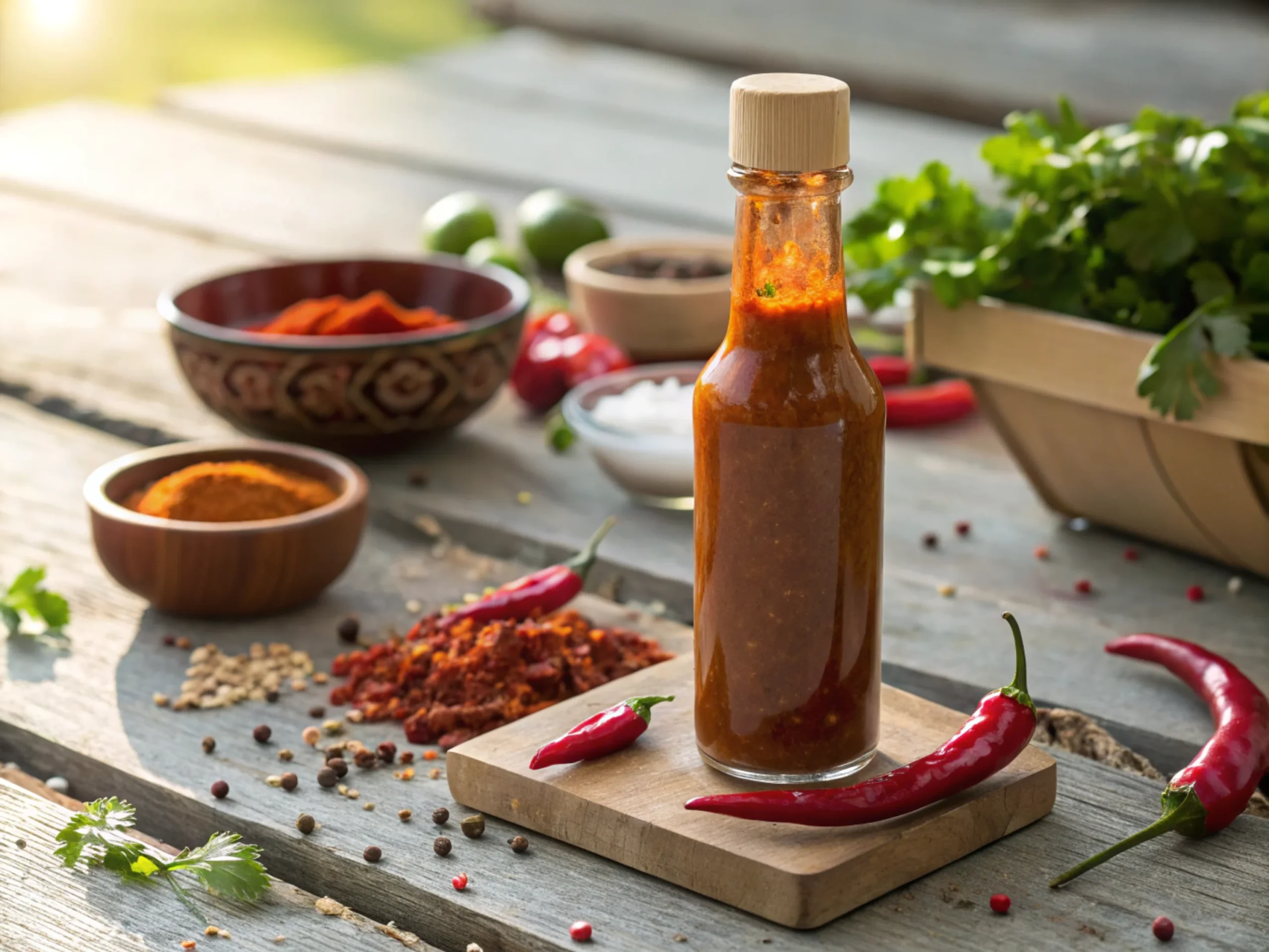Mexican hot sauce is more than just a condiment; it’s a cultural phenomenon that has captivated the palates of food lovers around the world. Known for its fiery kick and vibrant flavors, this versatile sauce is a staple in both traditional and modern cuisines. Whether drizzled over tacos, mixed into marinades, or used as a dipping sauce, Mexican hot sauce delivers a signature burst of heat that enhances any dish. In this article, we’ll uncover the secrets behind Mexican hot sauce, explore its history, and highlight its most iconic varieties.
Table of contents
The Distinctive Character of Mexico’s Spicy Sauces
What Is the Mexican Hot Sauce Called?
Mexican hot sauce, commonly referred to as salsa picante, is, without a doubt, a spicy and flavorful condiment that has become synonymous with Mexican cuisine. Additionally, the term encompasses a wide range of sauces made primarily from chili peppers, vinegar, and an assortment of spices. Moreover, while countless variations exist, all Mexican hot sauces share an unwavering dedication to bold flavors and aromatic heat.
In contrast to other hot sauces, such as Louisiana-style or Asian Sriracha, Mexican varieties often stand out for their earthy, smoky undertones, which are as complex as they are delicious. For instance, iconic brands like Valentina, Cholula, and Tapatío have become household names, each offering a unique take on this beloved condiment. Furthermore, these sauces are not just about delivering heat—they emphasize balance, depth, and versatility.
For example, Valentina hot sauce exemplifies this with its tangy and mild heat profile, making it a pantry favorite across the globe. Likewise, Cholula, with its distinctive wooden cap and nuanced blend of chili piquín and arbol flavors, has cultivated a devoted following. Therefore, these sauces are not merely condiments; they are, indeed, a celebration of Mexico’s rich culinary heritage.
Discover more about the most popular Mexican hot sauces, including their unique flavors and fascinating histories.
The Origins and Evolution of Spicy Mexican Sauces
Mexican hot sauce traces its roots to ancient civilizations, where chili peppers served as a dietary staple. The Aztecs and Mayans ground chili peppers to season their food, often mixing them with water or ground seeds to craft the earliest forms of salsa. This deep connection to chili peppers evolved over time. When Spanish colonists arrived in the 16th century, they introduced vinegar, which became a key ingredient and transformed simple chili blends into preserved sauces.
By the 20th century, Mexican hot sauce entered the commercial market, making it accessible to the masses. Brands like Valentina and Cholula began bottling their signature recipes, paving the way for the sauce’s widespread popularity. Today, these hot sauces are celebrated worldwide for their ability to elevate dishes, both traditional and modern.

Best Varieties of Spicy Mexican Sauces
Which Hot Sauce Is the Most Popular in Mexico?
When it comes to Mexican hot sauce, determining the “number one” variety often depends on personal preference and use case. However, a few brands have consistently stood out for their flavor, accessibility, and versatility.
Valentina is often hailed as a top contender, beloved for its rich, tangy flavor and approachable heat level. This hot sauce is perfect for everything from tacos to chips and has a loyal following among spice enthusiasts. On the other hand, Cholula is a favorite for those who prefer a milder, more nuanced flavor profile. With its blend of chili piquín and arbol, it pairs beautifully with eggs, grilled vegetables, and even soups.
Another strong competitor is Tapatío, known for its zesty flavor and medium heat. Tapatío is a versatile addition to dishes like enchiladas and tamales and works equally well as a cocktail enhancer for Micheladas.
These brands exemplify the diverse world of Mexican hot sauce, catering to different palates while maintaining the essence of authentic Mexican flavors.
The Mexican Version of Sriracha Sauce
For those who love the bold, garlicky heat of Sriracha, Mexican cuisine offers its own spicy alternative: Salsa Macha. This richly textured sauce is crafted by blending dried chilies with garlic, nuts, and oil. The result is a smoky, nutty flavor profile that’s distinctly Mexican. Unlike Sriracha’s smooth and tangy consistency, Salsa Macha has a chunky texture, making it an excellent topping for tacos, roasted meats, or even breakfast dishes like huevos rancheros.
Additionally, sauces like El Yucateco’s habanero blend cater to fans of intense heat, providing a fiery kick while preserving traditional Mexican flavors. These sauces highlight Mexico’s ability to innovate while staying true to its culinary roots.
To learn more about the various styles and uses of Mexican hot sauces, explore this comprehensive guide.
A Spicy Mexican Sauce Beginning with “AV”
When exploring the world of Mexican hot sauces, Aviña is a name that stands out. Though not as widely recognized as Valentina or Cholula, Aviña hot sauces are celebrated for their commitment to natural ingredients and bold, authentic flavors. These artisanal sauces often incorporate regional chili varieties, giving them a unique taste that appeals to adventurous palates. Aviña’s focus on small-batch production and quality ingredients ensures a hot sauce experience that’s as fresh as it is flavorful.

Spicy and Flavorful Recipes to Try
Traditional Mexican Dishes with a Spicy Twist
Mexican hot sauce is an essential ingredient in countless traditional dishes. Tacos al pastor, for instance, are often garnished with a generous drizzle of spicy salsa, enhancing the smoky sweetness of the marinated pork. Similarly, pozole—a hearty and comforting soup—benefits from the tangy heat of a few drops of Valentina or Cholula.
Hot sauce elevates enchiladas, another classic dish, by enhancing the filling or adding a flavorful finishing touch. The sauce’s tangy and spicy notes bring the layers of tortillas, cheese, and meat to life. Even snacks like elotes (grilled Mexican street corn) feel incomplete without a sprinkle of chili powder and a dash of hot sauce, creating the perfect balance of heat and creaminess.
In modern cooking, Mexican hot sauce has transcended traditional boundaries. Chefs worldwide are incorporating these sauces into fusion dishes, from spicy sushi rolls to fiery pasta sauces, proving that the versatility of Mexican hot sauce knows no limits.
Homemade Hot Sauce Recipe
Making your own Mexican hot sauce at home is easier than you might think and allows you to customize the flavor and heat level to your liking. Below is a step-by-step guide to crafting a delicious homemade salsa picante that rivals store-bought brands:
Ingredients:
- 10 dried guajillo chilies (seeded and de-stemmed)
- 5 dried arbol chilies (for extra heat)
- 4 cloves of garlic
- 1 medium onion (chopped)
- 2 cups water
- 1 cup white vinegar
- 1 teaspoon salt
- 1 teaspoon sugar (optional)
- 1 teaspoon ground cumin
Instructions:
- Toast the guajillo and arbol chilies in a dry skillet over medium heat until fragrant, being careful not to burn them.
- In a small saucepan, combine the toasted chilies, garlic, onion, and water. Bring to a boil, then reduce to a simmer and cook for 10 minutes.
- Allow the mixture to cool slightly, then transfer it to a blender. Add the vinegar, salt, sugar, and cumin.
- Blend until smooth, adding water as needed to achieve your desired consistency.
- Strain the sauce through a fine mesh sieve for a silky texture, or leave it unstrained for a chunkier sauce.
- Pour the hot sauce into sterilized bottles or jars and refrigerate. It will keep for up to two weeks.

This homemade recipe is not only cost-effective but also endlessly customizable. You can experiment with different chili varieties, spices, or even add roasted tomatoes for a unique twist.
Creative Uses Beyond Mexican Dishes
While Mexican hot sauce is a natural choice for tacos, burritos, and enchiladas, its uses extend far beyond traditional Mexican fare. Here are some creative ideas for incorporating hot sauce into your everyday meals:
- Marinades: Mix hot sauce with olive oil, lime juice, and garlic to create a tangy marinade for chicken, shrimp, or tofu.
- Dips: Combine hot sauce with sour cream, cream cheese, or Greek yogurt for a quick and zesty dip.
- Cocktails: Add a dash of hot sauce to your Bloody Mary or Michelada for a spicy kick.
- Pasta Sauces: Stir a spoonful of hot sauce into tomato-based pasta sauces for an extra layer of flavor.

Pro Tips & Variations
To make the most out of your hot sauce experience, consider these expert tips and variations:
Adjusting Heat Levels: For a milder sauce, use fewer arbol chilies or substitute them with milder options like ancho chilies. If you prefer extra heat, add habanero or ghost peppers.
Flavor Enhancements: Experiment with smoked paprika, oregano, or fresh cilantro to create complex flavor profiles.
Storage Tips: Always refrigerate homemade hot sauce to maintain freshness. Use sterilized containers to prevent spoilage.
Serving suggestions can also elevate your hot sauce game. Pair your sauce with fresh tortilla chips, drizzle it over avocado toast, or use it as a finishing touch for roasted vegetables. Its versatility ensures it will quickly become a staple in your kitchen. If you’re curious about expanding your culinary experiments, check out how kefir enhances cooking and baking.
FAQs
What Is the Number One Mexican Hot Sauce?
Valentina and Cholula are often considered the top contenders for the title of “number one Mexican hot sauce.” Both are beloved for their balanced flavors and versatility, making them staples in kitchens around the world.
What Is the Mexican Version of Sriracha Sauce?
Salsa Macha is a rich, chunky hot sauce made with dried chilies, garlic, nuts, and oil. Its smoky and nutty flavor sets it apart as a unique alternative to Sriracha.
What Is a Mexican Hot Sauce That Starts With AV?
Aviña is a lesser-known but highly regarded artisanal hot sauce brand that emphasizes bold flavors and natural ingredients.
Is Tapatío a Mexican Hot Sauce?
Yes, Tapatío is a Mexican hot sauce that originated in California but is inspired by traditional Mexican flavors. Its zesty and medium-heat profile makes it a favorite for a wide variety of dishes.
How to Store Hot Sauce for Maximum Freshness?
Store hot sauce in a cool, dark place or in the refrigerator to extend its shelf life. Homemade varieties should always be refrigerated.
What Is the Scoville Rating for Popular Mexican Hot Sauces?
Most Mexican hot sauces range from 1,000 to 3,000 Scoville Heat Units (SHU), making them milder compared to extreme hot sauces. Brands like Valentina and Cholula fall within this range.
Creative and Unconventional Ways to Use Spicy Mexican Sauces
Aside from traditional dishes, hot sauce can be used in soups, stews, and even desserts like spicy chocolate truffles.

Conclusion
Mexican hot sauce is more than just a condiment—it’s a celebration of flavor, culture, and versatility. From its ancient origins to its global popularity, this fiery sauce has remained an essential part of culinary traditions. Whether you’re drizzling it on tacos, whipping up a homemade batch, or exploring creative uses, Mexican hot sauce adds a burst of excitement to any dish.
So next time you reach for that bottle of Valentina or Tapatío, know that you’re not just adding heat—you’re embracing a rich cultural heritage that has stood the test of time. If you’re curious about incorporating hot sauce in innovative ways, explore how Hawaiian bread differs in flavor and texture. Spice up your meals and enjoy the bold, vibrant flavors of Mexican hot sauce!


1 thought on “What Is the Mexican Hot Sauce Called?”